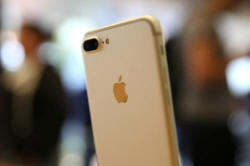|
Ceva licenses its designs to chipmakers such as Intel and
Samsung, who embed its digital signal processors within their
chip sets, reducing the time and cost it takes them to bring
products to market.
These "teardowns", as they are known in the electronics
industry, showed that for the first time Intel's thin modem,
which uses Ceva's design, is in some versions of Apple's new
smartphone. For the last several years Intel's competitor
Qualcomm dominated the market for these chips.
"Since 2012 our numbers were down because of Qualcomm," Ceva
Chief Financial Officer Yaniv Arieli told Reuters on Tuesday.
"This year that's changing and our customers are successful in
launching their own LTE chips," he added, referring to the chips
used in 4G mobile communications.
Ceva's Nasdaq-traded shares jumped 10.3 percent to a record
$34.99 on Monday in more than four times its daily average
volume.
Analysts raised their forecasts for the company, citing the
teardowns, which can be found on the websites www.chipworks.com
and www.ifixit.com.
"We view Ceva as one of the main beneficiaries from the launch
of the iPhone 7/7+," said Benchmark analyst Gary Mobley.
He estimated that Intel and Qualcomm may equally split the thin
modem supply for the iPhone, which could boost Ceva's adjusted
earnings per share in 2017 by as much as 25 cents. Analysts on
average forecast Ceva will earn 84 cents a share in 2016.
Canaccord raised its price target for Ceva to $40 from $38 and
its adjusted earnings per share estimate to $1.11 from $1.05.
Ceva estimates its designs will be included in almost 200
million LTE phones in 2016 and is targeting 400-500 million
phones annually within three years. Arieli said this was not
just from high-end Apple and Samsung phones but from emerging
economies where smartphones costing under $100 are more popular.
(Editing by Louise Heavens)
[© 2016 Thomson Reuters. All rights
reserved.] Copyright 2016 Reuters. All rights reserved. This material may not be published,
broadcast, rewritten or redistributed.
 |
|





